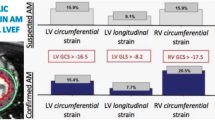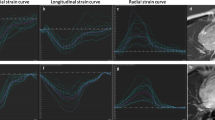Abstract
Cardiac magnetic resonance (CMR) assesses myocardial involvement in myocarditis (MYO). Current techniques are qualitative, subjective, and prone to interpretation error. Feature tracking (FT) analyzes myocardial strain using CMR and has not been examined in MYO. We hypothesize that regional left ventricular (LV) strain is abnormal in MYO. Regional strain by FT was compared to late gadolinium enhancement (LGE) and troponin leak as measures of myocardial involvement. This single-center, retrospective CMR study reviewed patients with clinical MYO and structurally normal hearts who underwent CMR at our institution. Young adults with normal cardiac anatomy, function, and absent LGE served as controls. MYO patients with documented troponin leak and normal global ejection fraction (EF > 50 %) were included in comparison. FT determined regional myocardial peak systolic strain (pkS) in longitudinal and circumferential distributions. T tests compared strain values between cases and controls. Receiver operating characteristic curves determined pkS values with highest sensitivity and specificity for concurrent troponin leak and LGE. FT was performed on 57 patients: 37 MYO and 20 controls. Twenty-eight cases with normal EF, and 20 control patients were included in final analysis. Nearly all cases with normal function demonstrated abnormal regional pkS (27/28, 96 %). Cases had significantly diminished pkS when compared to controls in all regions except the longitudinal 2C distribution. FT-derived longitudinal and circumferential pkS is sensitive and specific in identifying myocardial involvement, namely the presence of troponin leak and LGE. FT may be a useful adjunctive, objective measure of myocardial involvement in patients with MYO and normal LV function.

Similar content being viewed by others
Abbreviations
- CMR:
-
Cardiac magnetic resonance imaging
- MYO:
-
Myocarditis
- FT:
-
Feature tracking
- LV:
-
Left ventricular
- EF:
-
Ejection fraction
- LGE:
-
Late gadolinium enhancement
- pkS:
-
Peak systolic strain
- 4C:
-
Four chamber
- 2C:
-
Two chamber
References
Ashford MW, Liu W, Lin SJ, Abraszewski P, Caruthers SD, Connolly AM et al (2005) Occult cardiac contractile dysfunction in dystrophin-deficient children revealed by cardiac magnetic resonance strain imaging. Circulation 112(16):2462–2467
Augustine D, Lewandowski AJ, Lazdam M, Rai A, Francis J, Myerson S et al (2013) Global and regional left ventricular myocardial deformation measures by magnetic resonance feature tracking in healthy volunteers: comparison with tagging and relevance of gender. J Cardiovasc Magn Reson 15:8
Baccouche H, Mahrholdt H, Meinhardt G, Merher R, Voehringer M, Hill S et al (2009) Diagnostic synergy of non-invasive cardiovascular magnetic resonance and invasive endomyocardial biopsy in troponin-positive patients without coronary artery disease. Eur Heart J 30(23):2869–2879
Banka P, Robinson J, Uppu S, Harris M, Hasbani K, Lai W et al (2015) CMR techniques and findings in children with myocarditis: a multicenter retrospective study. J Cardiovasc Magn Reson 17:96
Cerqueira MD, Weissman NJ, Dilsizian V, Jacobs AK, Kaul S, Laskey WK et al (2002) Standardized myocardial segmentation and nomenclature for tomographic imaging of the heart. A statement for healthcare professionals from the Cardiac Imaging Committee of the Council on Clinical Cardiology of the American Heart Association. Int J Cardiovasc Imaging 18(1):539–542
Cho GY, Chan J, Leano R, Strudwick M, Marwick TH (2006) Comparison of two-dimensional speckle and tissue velocity based strain and validation with harmonic phase magnetic resonance imaging. Am J Cardiol 97(11):1661–1666
Francone M, Chimenti C, Galea N, Scopelliti F, Verardo R, Galea R et al (2014) CMR sensitivity varies with clinical presentation and extent of cell necrosis in biopsy-proven acute myocarditis. JACC Cardiovasc Imaging 7(3):254–263
Friedrich MG, Sechtem U, Schulz-Menger J, Holmvang G, Alakija P, Cooper LT et al (2009) Cardiovascular magnetic resonance in myocarditis: a JACC white paper. J Am Coll Cardiol 53(17):1475–1487
Greulich S, Ferreira VM, Dall’Armellina E, Mahrholdt H (2015) Myocardial inflammation—Are we there yet? Curr Cardiovasc Imaging Rep 8(3):6
Hinojar R, Foote L, Ucar EA, Jackson T, Jabbour A, Yu CY et al (2015) Native T1 in discrimination of acute and convalescent stages in patients with clinical diagnosis of myocarditis: a proposed diagnostic algorithm using CMR. JACC Cardiovasc Imaging 8(1):37–46
Ho SY (2009) Anatomy and myoarchitecture of the left ventricular wall in normal and in disease. Eur J Echocardiogr 10(8):iii3–iii7
Hor KN, Wansapura J, Markham LW, Mazur W, Cripe LH, Fleck R et al (2009) Circumferential strain analysis identifies strata of cardiomyopathy in Duchenne muscular dystrophy: a cardiac magnetic resonance tagging study. J Am Coll Cardiol 53(14):1204–1210
Hor KN, Gottliebson WM, Carson C, Wash E, Cnota J, Fleck R et al (2010) Comparison of magnetic resonance feature tracking for strain calculation with harmonic phase imaging analysis. JACC Cardiovasc Imaging 3(2):144–151
Hor KN, Gottliebson WM, Carson C, Wash E, Cnota J, Fleck R et al (2010) Comparison of magnetic resonance feature tracking for strain calculation with harmonic phase imaging analysis. JACC Cardiovasc Imaging 3(2):144–151
Kempny A, Fernández-Jiménez R, Orwat S, Schuler P, Bunck AC, Maintz D et al (2012) Quantification of biventricular myocardial function using cardiac magnetic resonance feature tracking, endocardial border delineation and echocardiographic speckle tracking in patients with repaired tetralogy of Fallot and healthy controls. J Cardiovasc Magn Reson 14:32
Khoo NS, Smallhorn JF, Atallah J, Kaneko S, Mackie AS, Paterson I (2012) Altered left ventricular tissue velocities, deformation and twist in children and young adults with acute myocarditis and normal ejection fraction. J Am Soc Echocardiogr 25(3):294–303
Mahrholdt H, Goedecke C, Wagner A, Meinhardt G, Athanasiadis A, Vogelsberg H et al (2004) Cardiovascular magnetic resonance assessment of human myocarditis: a comparison to histology and molecular pathology. Circulation 109(10):1250–1258
Morton G, Schuster A, Jogiya R, Kutty S, Beerbaum P, Nagel E (2012) Inter-study reproducibility of cardiovascular magnetic resonance myocardial feature tracking. J Cardiovasc Magn Reson 14:43
Rosen BD, Edvardsen T, Lai S, Castillo E, Pan L, Jerosch-Herold M et al (2005) Left ventricular concentric remodeling is associated with decreased global and regional systolic function: the multi-ethnic study of atherosclerosis. Circulation 112(7):984–991
Rosen BD, Saad MF, Shea S, Nasir K, Edvardsen T, Burke G et al (2006) Hypertension and smoking are associated with reduced regional left ventricular function in asymptomatic: individuals the multi-ethnic study of atherosclerosis. J Am Coll Cardiol 47(6):1150–1158
Rosset A, Spadola L, Ratib O (2004) OsiriX: an open-source software for navigating in multidimensional DICOM images. J Digit Imaging 17(3):205–216
Schuster A, Morton G, Hussain ST, Jogiya R, Kutty S, Asrress KN et al (2013) The intra-observer reproducibility of cardiovascular magnetic resonance myocardial feature tracking strain assessment is independent of field strength. Eur J Radiol 82(2):296–301
Sengupta PP, Tajik AJ, Chandrasekaran K, Khandheria BK (2008) Twist mechanics of the left ventricle: principles and application. JACC Cardiovasc Imaging 1(3):366–376
Sutherland GR, Di Salvo G, Claus P, D’hooge J, Bijnens B (2004) Strain and strain rate imaging: a new clinical approach to quantifying regional myocardial function. J Am Soc Echocardiogr 17(7):788–802
Uppu SC, Shah A, Weigand J, Nielsen JC, Ko HH, Parness IA et al (2015) Two-dimensional speckle-tracking-derived segmental peak systolic longitudinal strain identifies regional myocardial involvement in patients with myocarditis and normal global left ventricular systolic function. Pediatr Cardiol 36 (5):950–959
Yeon SB, Reichek N, Tallant BA, Lima JA, Calhoun LP, Clark NR et al (2001) Validation of in vivo myocardial strain measurement by magnetic resonance tagging with sonomicrometry. J Am Coll Cardiol 38(2):555–561
Author’s Contribution
James C. Nielsen, MD, was instrumental in study design, data analysis and interpretation, and critical revision of the manuscript. JN served as one of the two CMR readers for late gadolinium enhancement in myocarditis patients. JN was directly involved in critical revisions of the manuscript. Partho P. Sengupta, MD, was key to interpretation of feature tracking data, provided feature tracking interpretation, and was directly involved in critical revisions of the manuscript. Javier Sanz, MD, was key to interpretation of feature tracking data, provided feature tracking interpretation, and was directly involved in critical revisions of the manuscript. Shubhika Srivastava, MD, was directly involved in statistical analysis, data interpretation, presentation of results, as well as acting as a key editor on all manuscript revisions. Santosh Uppu, MD, was a critical contributor to study concept, design, data analysis, and statistical interpretation. SU served as one of the two CMR readers for late gadolinium enhancement in myocarditis patients. SU was directly involved in critical revisions of the manuscript.
Author information
Authors and Affiliations
Corresponding author
Ethics declarations
Conflict of interest
None.
Rights and permissions
About this article
Cite this article
Weigand, J., Nielsen, J.C., Sengupta, P.P. et al. Feature Tracking-Derived Peak Systolic Strain Compared to Late Gadolinium Enhancement in Troponin-Positive Myocarditis: A Case–Control Study. Pediatr Cardiol 37, 696–703 (2016). https://doi.org/10.1007/s00246-015-1333-z
Received:
Accepted:
Published:
Issue Date:
DOI: https://doi.org/10.1007/s00246-015-1333-z




